What is the Asbestos Removal Process?
2nd August 2018Asbestos was widely used in construction for many years before the hazards of using it were finally realised. Asbestos remains in many buildings, including pubs, houses and even schools. Recent times have unearthed the dangers of asbestos, and it is being found in structures across the UK regularly.
With our blog, Asbestos Waste Solutions have done our utmost to preach the necessity of hiring a professional when it comes to asbestos removal, but we’ve not always made it clear what exactly this process is. In this article, we will be detailing the various steps in professional asbestos removal, giving you a deeper insight.
Asbestos enclosures
Firstly, in order that the spread of asbestos fibre release is contained, enclosures must be formed in the area of operation. The enclosures are formed from polythene and are all diligently sealed with adhesive tape. If required, scaffolding may be used to support the enclosure.
In order to change the air within the enclosure continually, and to reduce the amount of asbestos fibres within the enclosure, the enclosure itself is placed under negative pressure. This doubles as a control measure, just in case the asbestos enclosure becomes unsealed.
In order to test the enclosure’s structural integrity, smoke tests can be carried out. If smoke can easily escape from the enclosure, then a leak can be identified and dealt with.
Clothing
When professionals remove asbestos, protective clothing must always be worn. The clothing is colour coded to ensure that the overalls are worn at the correct time.
Red – worn in live enclosures
Blue – worn in transit between enclosures and when transporting waste
White – for general use

Removal process
When it comes to the actual removal of the asbestos itself, there are a variety of methods that professionals can employ. Firstly, professionals can use a controlled wetting technique such as injection via needles or spraying, or alternatively, the asbestos can be encapsulated using a sealant which can be applied with roller and, when dried, forms a rubber protective barrier. Ultimately, this means that the asbestos cannot be released.
Completion
Once the asbestos has been removed in bulk or encapsulated, all of the surfaces within the asbestos enclosure must be environmentally cleaned to remove any remaining debris/residue deposits. In order to do this, the entire area of the asbestos enclosure is thoroughly vacuumed and wiped clean using industrial equipment.
Once this procedure has been completed, the area is then visually inspected by the site supervisor. Finally, after the inspection, responsibility is handed over to an independent UKAS accredited laboratory, who can then commence the certificate of reoccupation process.
Asbestos Waste Solutions provide professional, safe and efficient asbestos removal and disposal to commercial, industrial and domestic customers throughout the UK. From asbestos identification to collection, transportation and efficient disposal, we are dedicated to providing comprehensive asbestos management services to every customer. To find out more about the range of services we offer, get in touch with our friendly team today.


 Follow
Follow